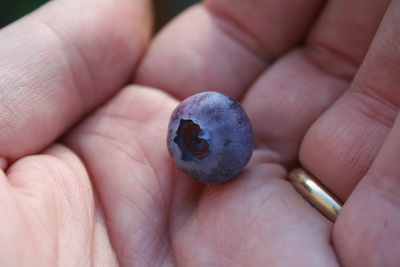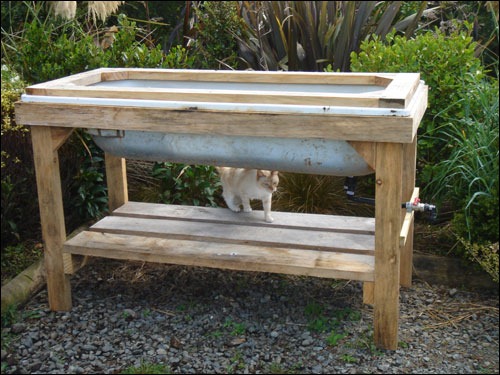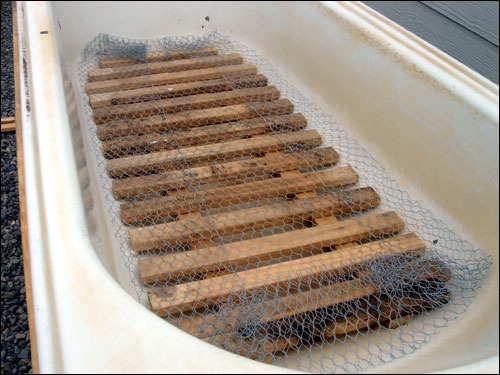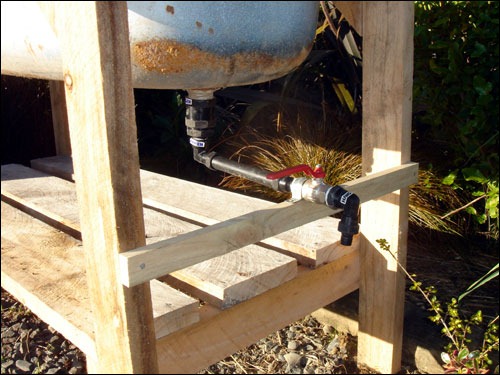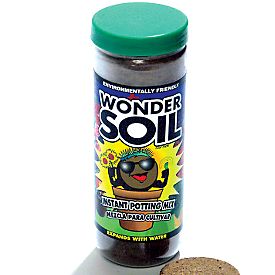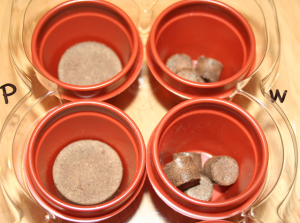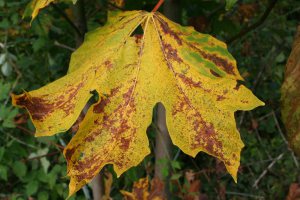How to prevent weeds in your garden
14.5 years ago organic, weed prevention, weeds
I doubt there is anyone who enjoys pulling weeds, though now at the end of the season is a great time to do some preventive measures to prevent new growth next season.
Kill your weeds early: The sooner you pull your weeds the easier it is to keep up with them. In addition, if you pick the weeds before the mature and flower and drop seeds you will save a ton of time pulling weeds for every one of those seeds that drop. Call me old fashioned but I normally skip the whole herbicide method and just pull the weeds by hand. Not only does your lawn or garden immediately look better, there is no coming back to see if the weeds need another dose of spray and the whole environmental part of keeping some chemicals out of our water system.
Mulch: This is one I didn’t completely understand until I had been gardening for a while. I for one never have found “beauty bark” beautiful and have always preferred the more natural look and benefits of fertile soil. But that is entirely why you want to use a mulch such as ground bark, straw, pine needles, leaves, newspaper, rubber bark, or even some old carpet. This helps prevent weeds in twp ways. First, it blocks light from the potential little weed seedlings to make their way to the surface. Second, they are not fertile mediums to grow seeds, which is exactly what you are looking for for your large flower beds which like to create good crops of weeds. As a final benefit they help insulate and hold water down for the plants you want to thrive having great growth and eventually shading out those “poor” weed seedlings. just 3-4 inches during the fall and your back should be bending over much less next spring.
If you are thinking, “What about my vegetable garden? I want seeds to be able to grow in there next year.” For your vegetable garden I highly recommend chopped leaves and a vegetable garden mulch. If you happen to have a leaf blower/vacuum that will chop them up all you need to do is empty those bags in a thin 1-2 inch layer across your garden. I used to have one of these though accidentally sucked up a rock which didn’t “chop” well and broke it so the alternate method I use is the following. Bag your leaves throughout the fall and once the leaves stop falling dump them out in a long row in your yard. Then use you lawnmower with bagger attachment and run them over until they are all chopped up. You can also do this more frequently during the fall but I find this a good time to use all the gas in the lawnmower before the end of winter feeling more like I am doing something more meaning other than just letting the mower sit there until it burns off the remaining fuel. With these leaves on the surface you smother any weed seeds and also block out all light to the soil. When spring time comes you simply work in the decomposed leaves into the soil and your garden has a head start with some good organic matter.
Pre-emergent weed control: For some parts of your yard like your lawn mulching is not really an options so to protect against pesky weeds like one of my personally loathing weed, annual bluegrass. Which grows and seeds so close to the ground it is nearly impossible to pull the plants to prevent the spreading. Pre-emergent herbicides is the solution to this problem. Pre-emergent herbicides work by preventing weed seeds from germination by inhibiting cell division in their tiny root system. Given these plants are annuals a successful application can rid you yard of these weeds until they eventually blower over from a neighbors. Pre-emergent herbicides can be purchased as a chemical or the organic method is applying glutton corn meal which normally can be purchased from your local feed store. One thing to remember is that this also will prevent you normal grass seed from germinating as well so be sure to time your application after with with enough lead time to allow the pre-emergent from wearing off.
Grow a cover crop: Growing a cover crop has two major benefits to your garden. Various legumes, grasses, and buckwheat make good options for for cover crops to plants while you garden is empty. First it creates a natural shade from the sun making it hard (or impossible) for seedlings are the surface to survive under their great shadows. Second it provides organic mater as “green manure” to add nutrients to your soil. One recommendation is to make sure you do a little research on the plant you choose as a cover crop, if you accidentally wait too long to “harvest” your cover crop it could go to seed and you may have an entirely new weed problem on your hands.
Cook the soil: When all else fails apply some black plastic (thicker the better) covering to your planting beds and let them “cook” throughout the fall/winter. Like mulch this will prevent any light and most water from entering the areas covered. This will essentially cook the soil killing any weeds, seeds, fungi, or anything else living in that area. Though this is very effective in eliminating weeds and disease from your soil it also kills everything else including good bacteria that your friendly worms like to visit your garden, so you soil may take sometime to recover and return to becoming living soil. I would recommend this method as a last result when the previous methods have proven to be completely unsuccessful.
Just for some positive outlook, you can also think of weeds as green manure assuming you are adding these to your compost, so even out of control they still can decompose and help your garden…
Tags: compost, garden seeds, organic vegetables, outdoor plants, vegetables, worms
Growing blueberries
14.5 years ago blueberry, cheap
If it were up to me every part of my landscaping would be edible. Though my homeowners association may disagree with me but blueberry bushes looks just as nice as any ornamental plant/bush when you visit the nursery with the obvious bonus of free food.
When selecting a blueberry bush, unless you are very patient spend about $10 a plant and get some more established ones (about 1/2 inch stem) You can get the two for $10 plants from your local Home Depot but you won’t be eating blueberries for a couple years. With the larger plants you should pinch off the blossoms to get better growth for the first couple years but I opt to getting my reward now instead of later and enjoy the handful of berries the young plants can produce.
When it comes to plant selection there are a large number of species to choose from with varying fruit size and harvest timing. I would recommend getting varieties that have varying maturity dates so you can enjoy those blueberries for a longer period of time. When I got my first two plants I went with Toro and Berkeley. The Berkeley is a very popular bush given it produces average size berries great for muffins/pancakes/cereal or the occasional snack with a mid-late harvest. The Toro on the other hand produces large (almost grape size) berries which are great for jams and snacks though bit of a mouthful for muffins. If you are curious of other varieties here is a great resource.
I have heard differing opinions on whether you need to have different species to successfully produce fruit after a little research I found this article which explains that blueberries are capable of pollinating with a single species, though studies have shown that having more varieties can produce larger and earlier fruits. So if you have a favorite variety you can go crazy with the single plant though a little diversity seems to always be a good thing.
When it comes to pest control the biggest pest is birds. You can control them by laying some netting on the plants, though in my personal opinion that just gets in the way of me getting my snacks so I opt for the lazy approach and just plant more plants and share with “neighbors”. Worse case I end up with a backyard with some bushes that look much nicer than my current evergreens, and I always can take up bird watching.
One of the most important parts to being successful with your little blueberry plants is soil preparation. The plants need to have an acidic soil and their roots like to remain moist, but not drowning in water. Given my area has an abundance of clay in my backyard, I naturally do not have either of these requirements. To give the plants a head start I dug a 1 foot wide/deep hole and filled it with peat moss and mixed with a few handfuls of compost. Not only will this retain water well, but the peat moss is also naturally acidic and will be a nice haven for a large family of worms in the next few years to add some awesome natural fertilizer (worm castings) Last I purchased I box of organic blueberry fertilizer which provides the primary and trace minerals as well as help keep the acidity of the soil up. I simply followed the directions on the box and watered the plants when there was a couple of days without rain.
Now some of you might be thinking, “hey it is fall why are you talking about growing blueberries” Well this is the “Cheap Vegetable Gardener, right now is a great time to visit your local nursery to pick up some of their “old overgrown” blueberry plants at bargain prices which you can plant now and enjoy some delicious berries next spring/summer.
Tags: birds, cheap, compost, led, organic vegetables, outdoor plants, vegetables, worms
Make a worm bin out of a bath tub
15.3 years ago vermicomposting, worms
Over at LifeBoat Farm they have created this great DIY Worm Farm out of an old bathtub. What I like about this build is they could have easily taken the bathtub propped it up on some cinder blocks and have been done with it. They took the extra effort with the wood enclosure (with bonus storage shelf) and proper drainage making use of the actual drain it almost appears that this is the true use for this bath tub.
Tags: worms
Using used coffee grounds in your garden/compost
15.3 years ago cheap, compost, fertilizer
 I have wanted to leverage used coffee grounds in my garden/compost but not being a coffee drinker myself I never seemed to be able to have the right timing to find any at local coffee shops. Recently a colleague taunted me with a picture from his cell phone of a few bags in the coffee shop in our cafeteria at work and my quest began.
I have wanted to leverage used coffee grounds in my garden/compost but not being a coffee drinker myself I never seemed to be able to have the right timing to find any at local coffee shops. Recently a colleague taunted me with a picture from his cell phone of a few bags in the coffee shop in our cafeteria at work and my quest began.
After just two days I have accumulated 40 lbs of coffee grounds, now how can I use this stuff in my garden?
- Throw it in your compost: Coffee grounds are 1.45% nitrogen and contain calcium and magnesium to add some trace minerals you may not get from your other organic material. Coffee grounds are a green material (I know coffee is brown, but same idea as grass clippings) so you should add with at least equal amounts of brown material (leaves) but if you are like me my browns are way to high already.
- Add it directly to your garden: I have seen some arguments that coffee grounds are acidic, but others claim it loses most (or all) of its acidity during the brewing process. Due to my natural curiosity I need to know the answer. So the answer is, it has an average pH of 6.9 so for all intents and purposes, it is neutral. Though if you are really tired and forget to brew it, it will be somewhat acidic.
- Fertilizer: Sometimes your plants need a little boost in the morning as well. Simply add a couple cups of coffee grounds to a bucket of water and let it seep for 24 hours and apply to plant in the same way you would compost tea. Using gardener terms I can’t think of any better name for this as “coffee tea” If you are busy/lazy you also can use it as a side dressing on top of your soil and let the rain seep it for you.
- Annoy your pests to stay out of your garden: It has been said that coffee grounds can deter cats from using your garden as their own personal commode. There are also reports that it can deter slugs as well. I am not sure if it is the abrasive soil effect on their sensitive underside or just the cruel reality that with their slow pace they can’t do anything with the caffeine rush they get. Coffee grounds may annoy ants to convince them to move their home elsewhere.
- Feed your worms: To worms this stuff is like ice cream, if you listen carefully you may hear them cheer your name when you add a handful to your worm bin when your greens from the kitchen may be a little lacking.
According to Starbucks brochure I picked up on my last visit, you should use the coffee grounds within 3 weeks to get the most nutrient value, though if you are composting I am sure you can start out the process in the bag if you really want to. Given that 16.34 billion pounds of coffee is produced each year there is plenty for you to save from ending up in a landfill. This is a great way to help the environment while also adding value to your garden without affecting your pocketbook.
Tags: cheap, coffee grounds, compost, organic vegetables, outdoor plants, worms
Using WonderSoil for seed starting
15.3 years ago cucumbers, fertilizer, indoor seed starting, vermicomposting, wondersoil
I had great results using coconut coir last growing season it was great to work with, retained water great for young seedlings, and was economically priced. The only challenge was actually finding some to use this year. No luck in local stores, last year I only could find a single block in one hardware store. Online there are plenty of locations that sell them, but unless you have a need for a couple metric tons, the cost of shipping can be more than the the product itself.
Finally, I found a solution to my problem WonderSoil Their main product line consists primarily of the same core component but they sell it in many different convenient sizes for various uses. One great feature of the product is it expands up to 12 times its original size. For someone like myself that does not have the space to store bags of peat/potting mix around my already full garage this is a great feature. You can check out all of their products but the ones that felt matched my growing needs were the following:
- Shake, Water, and Plant — 1/2 inch mini wafers that can be added to any of your pots. In my case I underestimated the expansion of these little things and made a little mess and it overflowed on my table (apparently 3 was the magic number not 4)
- The Tube — There are larger wafers made specifically for 4 inch pots, in my case this would be newspaper pots
- Reground Wafers — This is basically a loose version available in 2 or 5 lb bags. This is a more economical option which I will plan on using when doing larger seed trays.
For Christmas I got indoor seed starting kit which came with pots/seeds/peat pellets. I decided this would be a great opportunity to do a little side by side comparison. From the start I was WonderSoil seemed like the obvious winner. After adding a little water, it fully expanded in just a few seconds and was fluffy and ready for me to drop a seed in, the peat was a swampy mess.
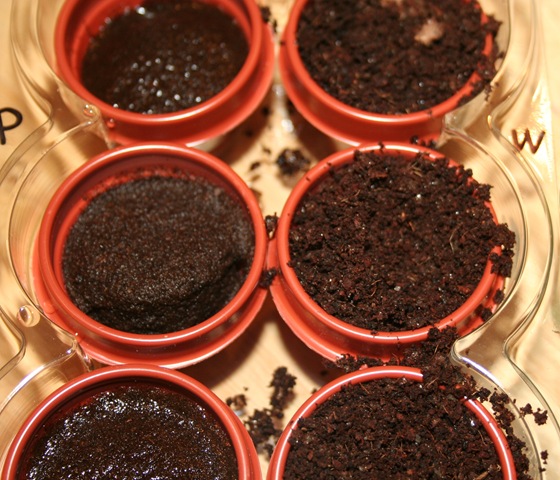
Peat pellets Left, WonderSoil Right
After a few minutes and fluffing with a fork the peat was ready to planting. I put cucumber seeds in both peat and WonderSoil pots and I will provide some updates on how things progress on my little experiment.
After the WonderSoil had some time to settle in my cheap LED grow box I did see some strange formations appear in the soil.
I little concerned I went back to their product and I believe this is their “water saving polymers” in action which I would assume is some sort of gel crystal which is supposed to save up to 50% water. They also boast about use of worm castings which I am definitely a fan of as well as addition of a balance of various micronutrients.
I will have to wait and see if the product produces as well as it claims, but I must say I am definitely impressed at this point and have high hopes for WonderSoil for this years seedlings.
UPDATES:
Christmas light LED grow box – Update #1 (WonderSoil)
Tags: cheap, compost, garden seeds, growbox, led, outdoor plants, vegetables, worms
Getting the garden ready for winter
15.5 years ago garden maintenance
The leaves are changing and falling the days are getting colder and I am personally coming to the end of my vegetable growing season. I do have a few post season activities before I completely call it a year.
Remove plants: Now my plants have lived a good life but now need to be removed. I mulch my lawn so I am always lacking greens for my compost bin so this is a good time to get some new materials. Most of my remaining plants are tomato, pumpkin, and cucumber plants which have some tough skins so I will chop them up with my lawnmower prior to add them to my modest bin. While you have your mower running this is a good time to let it keep running until it runs out of gas to avoid gumming up the engine when you fire it up next spring. This is also a good time to inspect and sharpen or replace the blade since if you are like me you will completely forget about this when you finally get around to mowing next spring.
Fertilize: If you only can fertilize one time throughout the year now is the time because turf grasses have the ability to store food during the winter months to allow a very quick rebound after the winter months. My primary concern is for my lawn which I am applying alfalfa pellets, since we have had some intense rains these past weeks they should break down quickly and not have the appearance of goose poo for too long. While applying I also allowed some to fall into by beds to help microbial activity and give my empty beds a head start for next spring. Be sure to avoid beds with and vegetation since you want to avoid any new growth with first hard freeze coming up.
Turning the soil: This can be a controversial activity since messing with the soil can inhibit microbial activity though turning the soil now can give you a head start next spring. My motivation is more on the lines if killing baby slugs (I know I am cruel) The slug activity in my garden was pretty minimal but I have concerns the few visitors may have decided to raise a family in my bed for next year. If I simply turn the first few inches of the soil I can expose the tiny slug eggs which birds will eat as a snack and any remaining will be destroyed during our first good frost. As an added benefit this will be a good time to catch up on my slacking in weeding during the last few weeks.
Taking care of your tools: Now is a good time to find those missing tools that may be hiding in your yard and garden. I have no idea why manufacturers choose to make these things green; almost like they want us to lose them to buy more ïŠ If you find any of your tools it is a good idea to put a light coating of oil on metal parts of your tools. You can also apply some Linseed oil to the wood portion of your tools.
Frosting on the top: At this point my garden is looking pretty good….even tempted to start planting though I will resist the urge. I have a plan to hold me over this winter but that will require its own post. After I have had a couple good frosts to kill off any slug eggs I will break open a couple of my bags of leaves and spread on a solid layer on top of my beds. Not only will this provide some food and temperature protection for the worms in my garden but whatever remains will be a great addition of organic matter for my garden.
Now with all this work I should be ready to start gardening way earlier than I should next spring…will I ever learn.
Tags: birds, cheap, compost, garden seeds, organic vegetables, outdoor plants, tomato plants, vegetables, worms
